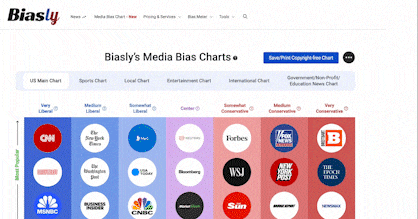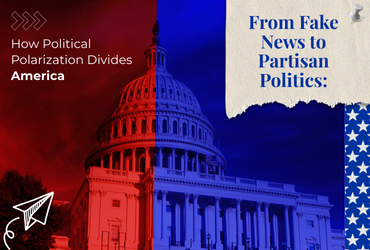
The United States has become increasingly polarized over the last generation or so. Both political parties used to have similar ideologies and factions within their parties. Currently, both parties have pulled further apart. This has led to less bipartisanship in Congress and caused stagnation on many legislative issues. In a multi-party democracy, division is natural because everyone is free to hold their views. But the recent trends are troubling. Many Americans have become so polarized that dehumanizing politicians has become normalized. This allows for violence against politicians and openly hostile opinions of those who have a different political orientation. The issue of political polarization is largely attributed to political bias in media forms.
How Media Shapes Bias
Broadcast and Cable News
Broadcast media is one of the factors to blame for the increase in polarization. Networks such as CNN, Fox News, MSNBC, and others all have their political biases and leanings. Political networks often show only their side of the story, portraying themselves as the good guys and the opposition as villains. This can often distort the facts in the process of getting their point across and appeasing their audience. The main goal of these networks is profit. To achieve this, they promote sensationalist news that keeps viewers engaged. Networks tend to do this even if it’s not the most politically relevant or accurate. These networks also downplay issues that hurt their side. At the same time, they promote stories that rile up supporters or make the opposition look worse. In doing so, they push narratives favorable to their party.
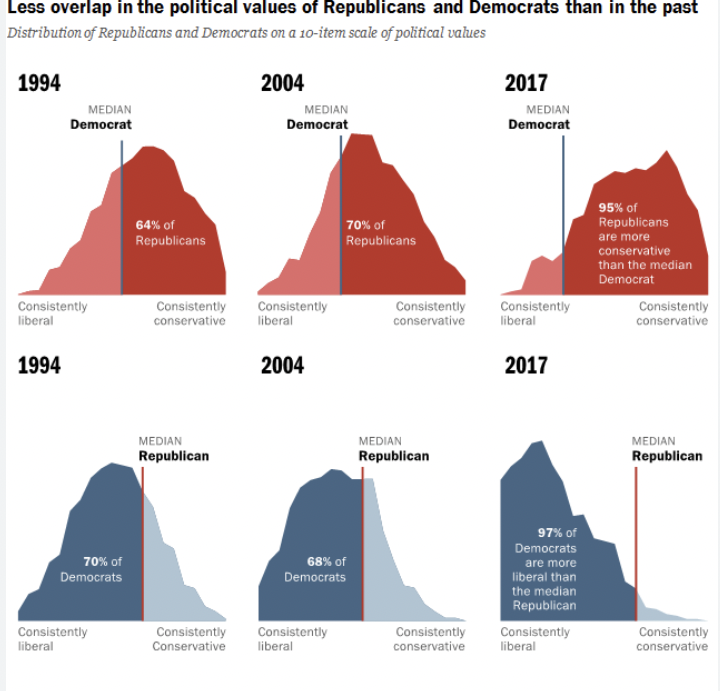
Chart: How both parties are finding less and less common ground. Source: Pew Research
This trend illustrates how partisan media coverage and political rhetoric have contributed to the shrinking space for compromise.
Social Media’s Role
Social media is another factor in the increase of political polarization. Social media has allowed more creativity to be published and given people more access to share their opinions. However, accessibility has created an avenue for anyone to publish any type of content, with little restriction. This can cause widespread misinformation from users who claim to be experts, and political content is no exception. Many publish content for attention, but often that content is exaggerated or outright false. A sizable audience sees the content, and many accept what they see as fact. For some content creators, the misinformation is unintentional, but for others, their goal is to lead people down a path of misinformation and conspiracy. Continuation of this leads to many people having an incorrect view of political issues and becoming more polarized. Others share content that lacks context and makes a certain group or party look bad, and people start to believe that the content they see is valid. When this happens, they begin to believe stereotypes and narratives about political parties or their groups. There is also a rise in the number of people whose primary source of news comes from social media platforms, and much of the news they receive is rife with misinformation. This is why social media plays a role in media polarization.
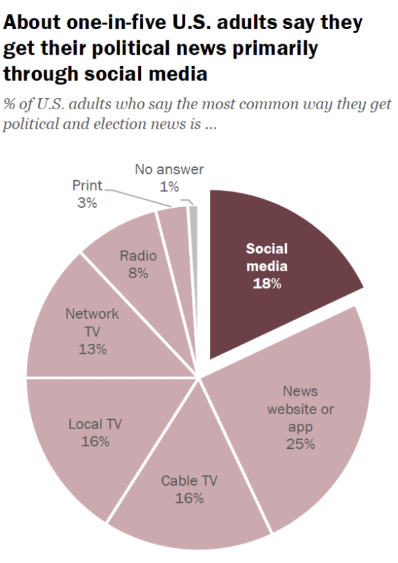
Chart: Increase in people who get their news from social media. Source: Pew Research
The rise of social media as a primary news source shows how misinformation can spread more widely and deeply than in traditional media.
The Role of Talk Radio and Podcasts
Talk radio and political podcasts have become increasingly influential in shaping public opinion. Many of these programs adopt a partisan tone, catering to audiences who already agree with the host’s political leanings. This creates an environment where listeners are exposed to a narrow set of ideas, reinforcing their beliefs while dismissing alternative perspectives. Unlike traditional news, these programs often blur the line between commentary and factual reporting, leading audiences to treat opinionated rhetoric as fact. Podcasts in particular have surged in popularity, offering long-form political discussions that can frame issues in a biased way without immediate fact-checking. This contributes to polarization by deepening ideological divides and making compromise less appealing. Because these formats reach millions daily, their impact on political discourse is significant and growing.
Echo Chambers and Algorithms
Social media and partisan networks reduce the diversity of opinion. Many networks increase polarization as they only broadcast the side they support and give little to no time to the other side. Whenever there is breaking news or some kind of big political event, many Americans see it only through the lens of whatever network they are watching. This means that network often portrays the news as one-sided and simplistic. However, there are more dynamic factors in the story that another political viewpoint would cover. This causes a feedback loop with people becoming increasingly consumed by like-minded news instead of seeing political news from other perspectives. Social media algorithms promote content similar to what users already see. This reduces exposure to diverse opinions and pushes people further from the political middle, increasing polarization. When it comes to networks, many Americans do not take the time to view other networks with different partisan leanings and instead view content that fits their political views. This also contributes to the rise in polarization as the diversity of political opinions is reduced. In addition to people often only watching news from one side of the political spectrum, many Americans do not have much personal interaction with those of different political beliefs, thus limiting the exposure many people have to more diverse opinions.
Polarization Among the People
Erosion of Trust in Media
Another way America has become polarized politically is through the erosion of trust in media sources. The issues plaguing the partisan nature of political networks have led to some people losing trust in the news in general. Due to the aforementioned reasons, people are more skeptical of the media, but the erosion of trust has led many Americans to reject basic facts that a media outlet is not skewing. Rather, they are more welcoming of lesser-known outlets that routinely promote outlandish theories. When both sides lose trust in mainstream networks, the country gets pulled apart. Without agreement on basic facts and logic, finding middle ground becomes impossible.
Amplification of Extremism
Amplifying extremism is another avenue that has created more polarization in America. In the past, it seemed as though no one in terms of media outlets tried to justify extremism, but now many outlets are quick to point out or label the other side as extremists, but do not do the same when their viewers or supporters act in that manner. Failure to denounce extremist behavior like rioting and hate crimes fuels even more extremism in politics. Because the media will continue to get worse when too many people fail to acknowledge and denounce those behaviors from the fringes, which are becoming increasingly more mainstream. There are also fringe news sources that have grown in popularity that are even more divisive than mainstream partisan-leaning news sources. Their opinionated news and falsehoods contribute to the rise in political polarization in recent years.
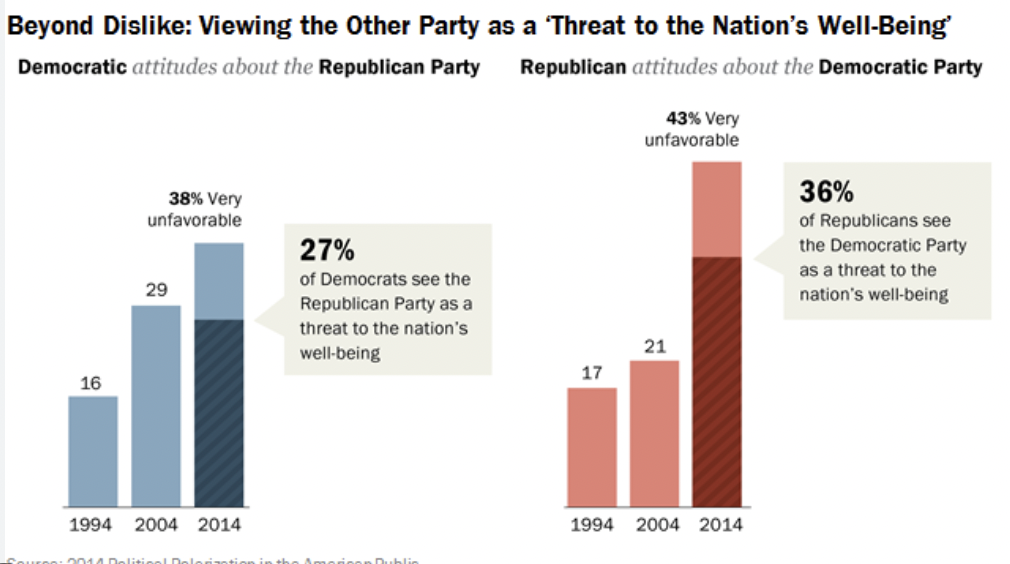
Graph: Polarization causing some Democrats and Republicans to see each other as existential enemies. Source: Pew Research
This graph reflects how deep divisions have escalated from disagreement into open hostility between ordinary citizens.
Economic Incentives Behind Polarized Media
Another driver of polarization is the economic model that underpins much of today’s media. Both traditional outlets and digital platforms rely heavily on advertising revenue, which is maximized by keeping audiences engaged. Unfortunately, the content that sparks the most engagement is often sensational, partisan, or emotionally charged. Outlets quickly learn that catering to polarized viewpoints generates more clicks, higher ratings, and greater profits. This creates a cycle where polarization is not only tolerated but actively encouraged by business models that reward division. As a result, stories that might encourage compromise or present balanced perspectives are often sidelined in favor of content that intensifies partisan outrage. This financial incentive to stoke division further entrenches polarization, making it less about ideology and more about sustaining a profitable media ecosystem.
Politicians and Divisive Rhetoric
The polarization of media bias can also be attributed to politicians. In recent years, politicians on both sides have sought to dehumanize their opponents during election cycles, interviews, or rallies. Examples include using incendiary rhetoric that trickles down to their supporters and is picked up by media outlets. When networks relay divisive messages from politicians, it normalizes the rhetoric. This pushes people on both sides further apart, creating not just disagreement but also hostility.
When supporters follow divisive rhetoric, they normalize it and start believing the stereotypes or claims made by their preferred candidates. Their supporters then start to distance themselves from those who do not share the same opinions and would rather surround themselves with like-minded people. This creates an environment where many Americans rarely interact with people of different beliefs, making it harder to understand opposing opinions. Therefore, politicians play a large role in the increase of media bias and polarization, as they are individuals who hold more influence. For instance, when they appear on TV or publish one-sided op-eds, they create a culture where people are increasingly divided along party lines. Politicians have also contributed to polarization with their unwillingness to compromise on issues. For example, party members refusing to help the president when he is from the opposing party more often than not.
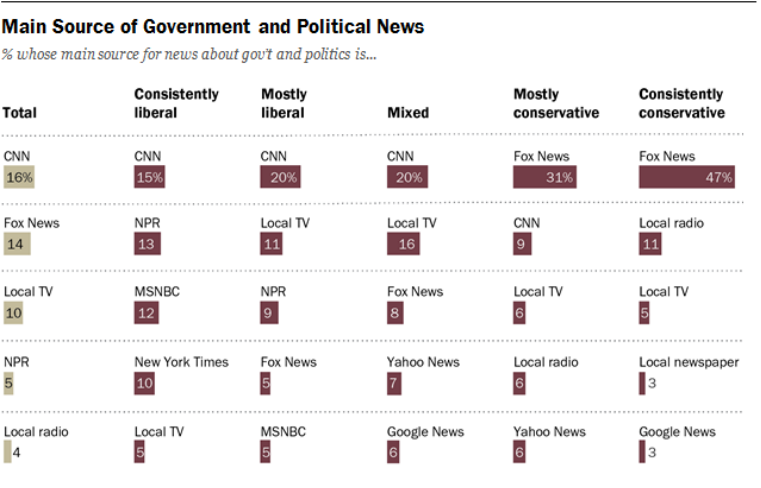
Table: Where Americans across the political spectrum get their news from. Source: Pew Research
This table highlights how news consumption patterns vary by party, reinforcing echo chambers and limiting cross-party understanding.
Conclusion
Media in the forms of social or television have evolved in ways that have made their content increasingly partisan. This has led politicians to become more partisan themselves, and that has all combined to make the nation more polarized, as people are more likely to watch news from one source rather than from multiple diverse sources, and be more welcoming to fringe political narratives. This has brought forth high levels of political polarization in recent years.


























